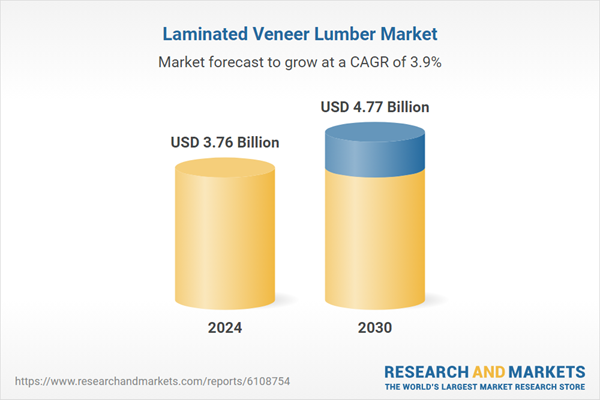Speak directly to the analyst to clarify any post sales queries you may have.
10% Free customizationThis report comes with 10% free customization, enabling you to add data that meets your specific business needs.
Key Market Drivers
Increasing Demand for Sustainable Construction Materials
The market is expanding steadily, fueled by growing demand for environmentally responsible building materials. LVL, made from fast-growing softwoods like pine and spruce, serves as a renewable and eco-friendly substitute for conventional materials such as steel and concrete. Its production conserves old-growth forests and supports carbon reduction goals. The product’s strength, stability, and versatility make it highly suitable for a variety of structural applications. Regions like North America and Europe, where regulatory frameworks and certifications like LEED and BREEAM are prevalent, are especially driving adoption. The preference for low-carbon, high-performance building materials positions LVL as a strategic solution in the global shift toward sustainable construction.Key Market Challenges
High Production Costs and Price Sensitivity
A major barrier for the LVL market is the comparatively high cost of manufacturing. Production involves sophisticated veneer processing machines, advanced adhesives, and precise pressing equipment, which require substantial capital investment. These costs are further elevated by quality control and compliance requirements. Despite LVL's superior performance, its premium pricing often limits use in budget-sensitive projects, particularly in affordable housing and cost-driven commercial developments. Competing materials like dimensional lumber, steel, or concrete may be favored due to their lower upfront costs. This price sensitivity continues to challenge market penetration, particularly in regions with limited awareness or demand for engineered wood.Key Market Trends
Rise of Green Building Practices and Sustainability Imperatives
A prominent trend driving the LVL market is the growing focus on green construction and carbon reduction targets. With global attention shifting toward sustainable design, engineered wood products like LVL are being recognized for their low environmental impact. LVL contributes to carbon sequestration and utilizes smaller-diameter logs and residual wood, aligning with circular economy principles. It is an increasingly preferred choice in sustainable architecture and infrastructure due to its environmental credentials. Governments, developers, and corporate entities striving for carbon neutrality are driving demand for materials that meet stringent sustainability standards, making LVL an attractive option in the evolving green construction landscape.Key Market Players
- Weyerhaeuser Company
- Boise Cascade Company
- Georgia-Pacific LLC
- Stora Enso Oyj
- Metsä Wood (Metsä Group)
- West Fraser Timber Co. Ltd.
- Universal Forest Products, Inc. (UFP Industries)
- Homasote Company
- SmartLam NA LLC
- Nelson Pine Industries Ltd.
Report Scope:
In this report, the Global Laminated Veneer Lumber Market has been segmented into the following categories, in addition to the industry trends which have also been detailed below:Laminated Veneer Lumber Market, By Type:
- Cross-Banded Laminated Veneer Lumber
- Laminated Strand Lumber
- Billet Laminated Veneer Lumber
Laminated Veneer Lumber Market, By Thickness:
- Less than 30 mm
- 30 mm to 60 mm
- Above 60 mm
Laminated Veneer Lumber Market, By End-Use Industry:
- Residential Construction
- Commercial Construction
- Industrial Construction
- Infrastructure
Laminated Veneer Lumber Market, By Region:
- North America
- United States
- Canada
- Mexico
- Europe
- Germany
- France
- United Kingdom
- Italy
- Spain
- South America
- Brazil
- Argentina
- Colombia
- Asia-Pacific
- China
- India
- Japan
- South Korea
- Australia
- Middle East & Africa
- Saudi Arabia
- UAE
- South Africa
Competitive Landscape
Company Profiles: Detailed analysis of the major companies present in the Global Laminated Veneer Lumber Market.Available Customizations:
With the given market data, the publisher offers customizations according to a company's specific needs. The following customization options are available for the report.Company Information
- Detailed analysis and profiling of additional market players (up to five).
This product will be delivered within 1-3 business days.
Table of Contents
Companies Mentioned
- Weyerhaeuser Company
- Boise Cascade Company
- Georgia-Pacific LLC
- Stora Enso Oyj
- Metsä Wood (Metsä Group)
- West Fraser Timber Co. Ltd.
- Universal Forest Products, Inc. (UFP Industries)
- Homasote Company
- SmartLam NA LLC
- Nelson Pine Industries Ltd.
Table Information
| Report Attribute | Details |
|---|---|
| No. of Pages | 185 |
| Published | July 2025 |
| Forecast Period | 2024 - 2030 |
| Estimated Market Value ( USD | $ 3.76 Billion |
| Forecasted Market Value ( USD | $ 4.77 Billion |
| Compound Annual Growth Rate | 3.8% |
| Regions Covered | Global |
| No. of Companies Mentioned | 10 |









